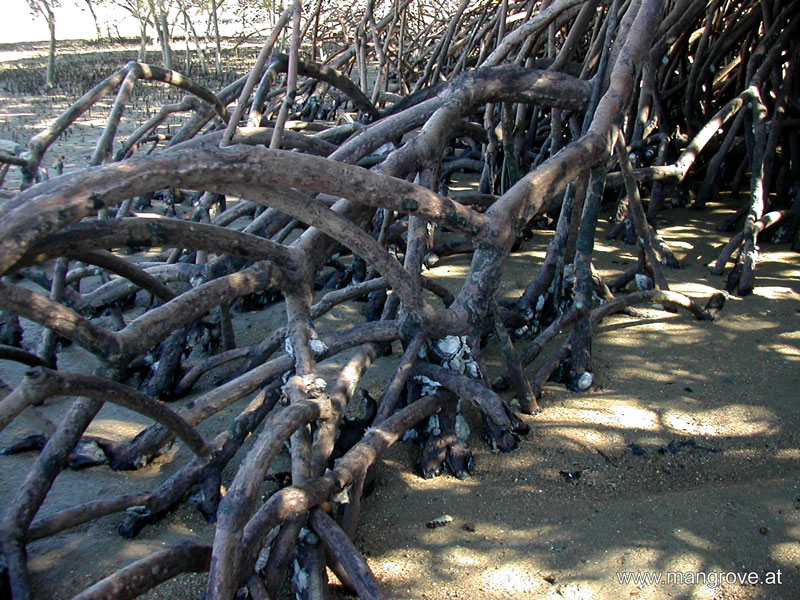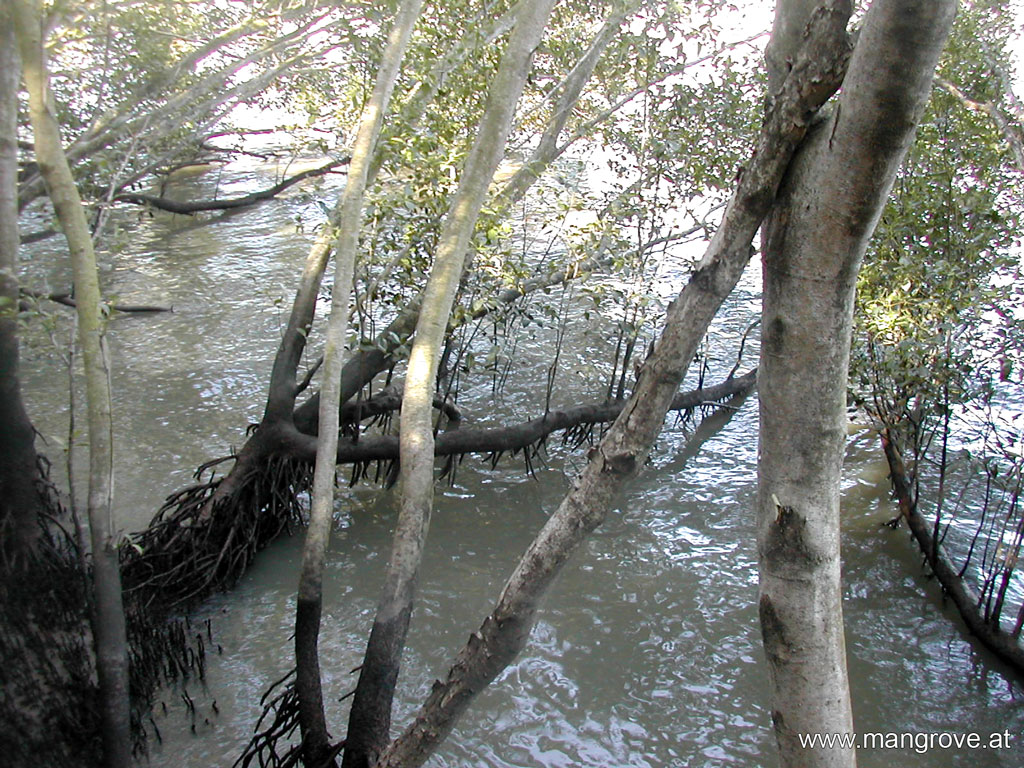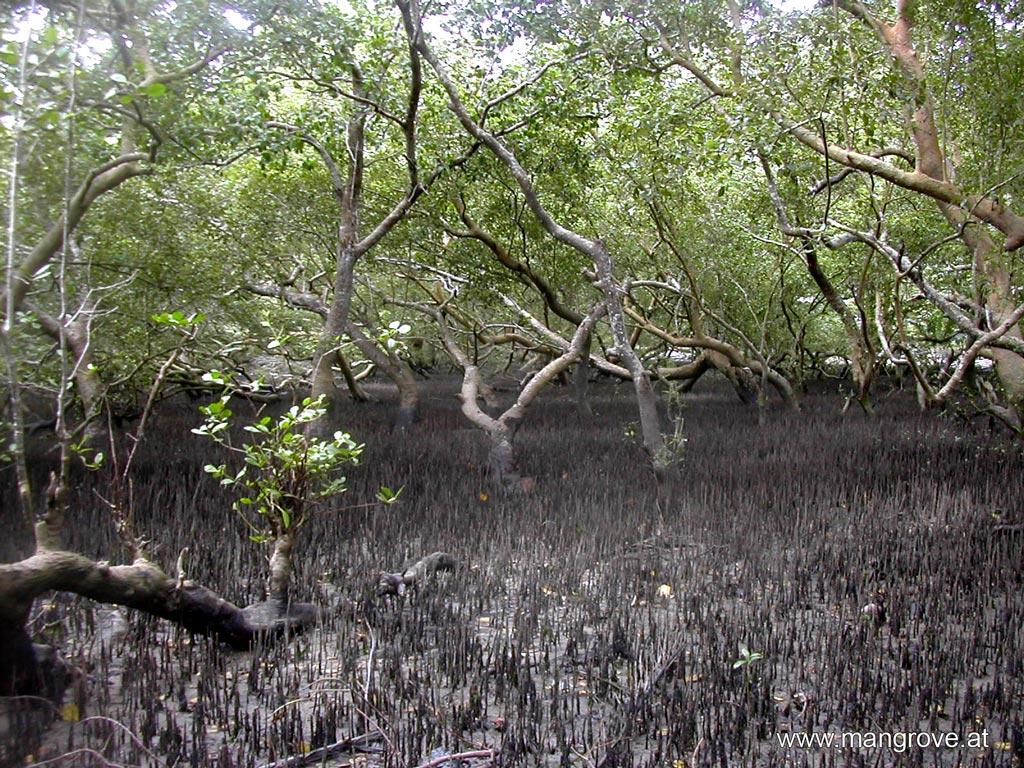 |
|
 |
|
 |
|
|
|
|

|
mangrove roots
|
|
|
Mangroves have three basic organs lika any other ordinary plant, the stem, the leaf and the root.
The root system of mangroves is divided as in other plants in three main groups, flat root system, heart root system and top root system.

flat root system Avicennia marina
|
The flat root system's primary root is hardly or not at all developed, therefore the lateral roots are strongly developed. Flat root systems are found especially in solid, dense and impermeable soils. Concerning mangroves especially Avicennia species develop flat root systems and therefore have an advantage compared to other mangrove species as they can easily establish in sandy, stony and rocky coastlines.
|

heart root system Rhizophora mangle
|
The heart root systems develops many, differently strong main roots simultaneously which grow vertically into the ground. Especially mangroves like Avicennia, Ceriops, Rhizophora and Sonneratia species as well as Nypa fruticans and Pelliciera rhizophorae, mangroves that often grow directly in the tides and need to protect their location, depend on the successful heart root system which develops roots like anchors in all directions. This characteristic increases the chances for these mangrove species to survive and grow in different areas like muddy, sandy, rocky or coral-like soils and coasts.
|

tap root system Barringtonia asiatica
|
The tap root system develops one single, strong and dominant main root that grows vertically into the ground. This main root has the ability to reach groundwater. This ability is not really necessary for mangroves growing in the tides but for mangroves growing a little bit more inland like Barringtonia asiatica for example. Dry and well drained soil is a typical feature of plants developing tap root systems.
|
Compared to other plants mangroves differ visually especially by their famous and typical aerial roots and biologically through the ability to grow in saline areas. Not only mangroves develop aerial roots also plants in every household like orchids, philodendron, ficus and many others develop aerial roots but not as impressive as mangroves do. The mangroves diversity concerning aerial roots is simply amazing.
Aerial roots are roots with various abilities and functions, primary gas exchange in oxygen-poor soils. The aerial roots are divided into groups as follows:
Stilt roots
Knee roots
Pencil roots
Peg roots
Buttress roots
Spreading roots
no aerial roots
Pencil roots and cone roots are also called pneumatophores.
|
|
|
|
|
Stilt roots also called prop roots are developed by Rhizophora species and Pandanus species.

Rhizophora mucronata stilt roots
|
Stilt roots outgrow the trunk of the mangrove, branches or already existing stilt roots.
As soon as stilt roots reach the ground the tip of the stilt root develops an underground root system with which it connects the stilt root into the ground and then develops one or more further stilt roots which grow arcuately into the air to again run into the ground to develop an underground root system, this process repeats several times.
|

underwater stilt roots
|
If the stilt root hits water instead of soil the stilt root will grow underwater toward the soil in the ocean or any other subject, a reef or some corals for example, that the stilt root can hold on to and be rooted to. Once the tip of the stilt root meets a subject it can root to many smaller roots develop to anchor themselves to the subject or in the soil.
|

supporting stilt roots

stilt roots
|
Stilt roots have numerous functions one of the most important one of the most important one is to uphold the mangrove and ensure its growing space. The tides are rough, huge waves, strong winds, tropical storms such as typhoons and hurricanes do not make it easy for mangroves.
If a tropical storm comes along with all its power mangroves are the one to be hit first and then other plants, animals and humans, this is the reason why there have been just small damages in areas behind the mangroves during the tsunami in december 2004, mangroves protect the coast in many ways.
To ensure living in the tides it is important for Rhizophora mangle to develop numerous massive stilt roots.
|

stilt roots lenticels
|
Another important ability of stilt roots is to allow the exchange of gas in oxygen-poor sediments.
The arc-shaped prop roots often can be found with a huge amount of lenticels that allow gas exchange in the oxygen-poor soils. Hence the popular term aerial roots. Stilt roots growing in soils with sufficient oxygen often only have a supportive function and do not develop so many lenticels.
Stilt roots of a fully grown Rhizophora in perfect growing conditions can be 5 meters long and extend in a radius of approximately 10 meters around the trunk. The extent of stilt roots are strongly influenced by the growing conditions and are affected by climate and soil.
|

underwater mangrove habitat
|
As humans we often see the stilt roots above the water surface, the entangled root system of stilt roots under water can be huge and very impressive, it provides useful services to its environment. Countless animals, especially fish, seahorses, shells and crustaceans find shelter in the root system of mangrove stilt roots, they provide protection from predators and a perfect nursery.
|

mangrove island
|
Stilt roots bind sediments and ensure sustainable coastal protection by sediment accumulation and counteract coastal erosion. Often small mangrove islands develop which accumulate biomass over decades. Biomass produced by mangroves is 3 kilogram per square meter a year, leaves, flowers, fruits and other biomass support the accumulation of sediments.
|

Bruguiera gymnorhiza with stilt roots

Avicennia marina with stilt roots, Brisbane (Australia)
|
Avicennia and Bruguiera species can develop additional stilt roots in a few cases, especially when they are in danger to lose their location.
These stilt roots prevent the tree from being uprooted. This happens often when the tree is outwashed by rising sea level, tides, human influences or the like. Furthermore these stilt roots provide to ensure the location the mangroves is growing at. Even single branches can develop these stilt roots to support them. Bruguiera gymnorhiza as well as Avicennia marina with stilt roots are normally found in riverine mangrove forests growing along rivers.
|
|
|
|
|
|


Bruguiera gymnorhiza knee roots
|
Knee roots are developed by Bruguiera species.
Knee roots emerge as a root loop from the underground root system and allow the exchange of gases in oxygen-poor sediments. Each underground horizontally growing root develops several knee roots at regular intervals.
Knee roots of an adult Bruguiera gymnorhiza for example extend in a radius of approximately 10 meters around the trunk and can reach a heigt of up to 60cm.
The knee roots of the different Bruguiera species differ in size, shape and frequency and can vary depending on the location and growth conditions.
Most knee roots have numerous lenticels with the ability to exchange gas.
|
|
|
|
|
|

pencil roots of Avicennia officinalis, Philippines
|
Pencil roots belong to pneumatophores, under the mangroves only Avicennia species develop pencil roots. Pneumatophore is Greek, 'pneuma' means something like 'air flow' and 'phoros' something like 'bearing', in English the word aerial roots are also very common for pneumatophores. Pneumatophores are roots that grow vertically up from the underground root system.
|

pneumatophores with lenticels

laid-free, flat root system of Avicennia marina, Australia
|
Avicennia species grow in oxygen-poor sediments. The underground root system needs and demands oxygen, the soil is not able to support the underground root system with enough oxygen, therefore the underground root system outgrows aerial roots that grow vertically up to the air above the soil. The pencil roots have numerous lenticels that enable gas exchange directly above the surface. The pencil roots provide the additional needed oxygen which can't be taken from the soil.
During high tide the surface tension of the water prevents the inflow of water into lenticels, therefore no gas exchange is possible while the pneumatophores are under water. Permanent inundation of pneumatophores lead to the death of the root system and therefore the mangrove.
Avicennia mangroves develop a flat root system, the underground, horizontally growing roots grow away the trunk and develop pencil roots in regular intervals which grow up to 30cm in height, measured from the soil to the tip of the pencil root. Pencil roots do not have the abiltiy to develop branches and normally have a diameter of 4 to 7mm. Die outer layers of pencil roots contain chlorophyll, pencil roots do have the ability to go through the process of photosynthesis.
|

pencil roots of Avicennia marina, Australia
|
Pencil roots (pneumatophores) are classic for Avicennia species and can grow within a radius of 10 meters around the trunk.
|
|
|
|
|
|

cone roots of Sonneratia alba, Philippines
|
Cone roots belong to pneumatophores and are developed by Sonneratia species and Xylocarpus moluccensis. Pneumatophore is Greek, 'pneuma' means something like 'air flow' and 'phoros' something like 'bearing', in English the word aerial roots are also very common for pneumatophores. Pneumatophores are roots that grow vertically up from the underground root system.
|

pneumatophores with lenticels

pneumatophore / cone root
|
Sonneratia species grow in oxygen-poor sediments. The underground root system needs and demands oxygen, the soil is not able to support the underground root system with enough oxygen, therefore the underground root system outgrows aerial roots that grow vertically up to the air above the soil. The cone roots have numerous lenticels that enable gas exchange directly above the surface. The cone roots provide the additional needed oxygen which can't be taken from the soil.
During high tide the surface tension of the water prevents the inflow of water into lenticels, therefore no gas exchange is possible while the pneumatophores are under water. Permanent inundation of pneumatophores lead to the death of the root system and therefore the mangrove.
Sonneratia mangroves develop a flat root system, the underground, horizontally growing roots grow away the trunk and develop cone roots in regular intervals which normally reach a height of 40 to 60cm, measured from the soil to the tip of the cone root. Sometimes, when perfect growing conditions are provided, the cone roots can reach up to 3 meters in heigt. Cone roots do have the abiltiy to develop branches and normally have a diameter of 2 to 6cm under perfect growing conditions up to 15cm. Die outer layers of pencil roots contain chlorophyll, cone roots do have the ability to go through the process of photosynthesis.
|

Sonneratia alba
|
Cone roots of Sonneratia species can grow in a radius of more than 10 meters around the trunk.
|
|
|
|
|
|

buttress roots Heritiera littoralis, Japan
|
Buttress roots are developed by many trees, concerning mangroves especially Heritiera littoralis and Pelliciera rhizophorae are famous for their buttress roots.
Buttress roots provide huge trees stability, especially in tropical areas, and the buttress roots can grow up to 10 meters in heigt. Buttress roots, also called buttresses do not continue their growth underground as they do above, underground buttresses develop a huge amount of small roots that grow in the soil under the buttress root.
|
|
|
|
|
|

spreading roots
|
Spreading roots are developed by Ceriops species.
Spreading roots do also provide stability and normally do not exceed 1 meter in height. Spreading roots grow similar as buttress roots do with numerous small roots underground.
|
|
|
|
|
|

Barringtonia asiatica
|
Generally we can say that aerial roots belong to true mangroves and false mangroves do not develop any aerial roots at all.
Mangroves that do not develop any aerial roots as Barringtonia species for example normally grow more inland where the soil is richer in oxygen and spared by the tides. The growing conditions do not require the mangrove to develop aerial roots to support the underground root system with additional oxygen.
|
|
|
|
|
|
|
|
|
 |
|
 |
|






